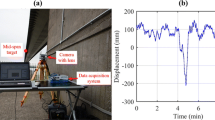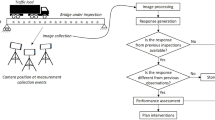Abstract
Deflection measurements on structures continue to be a challenge with current sensor technologies. Material degradation and changes in the mechanical properties over time (e.g. creep and shrinkage in concrete bridges) directly impact the deflections exhibited by a structure. In this article, we introduce and discuss the evaluation of a novel laser- and video-based displacement sensor prototype to monitor displacements and rotations on structures remotely. The sensor is inexpensive, using off-the shelf components, but also accurate and practical for situations that do not allow the use of conventional displacement sensors, which require a reference base. In contrast to other image-based approaches such as digital image correlation (DIC) or Eulerian-based virtual video sensors (VVS), the digital camera of our proposed solution is located at the measurement location on the structure. The sensor was evaluated using laboratory tests to determine the practicality, accuracy, and sensitivity to lighting conditions. The accuracy of the sensor was found to be approximately ± 0.9 mm (± 0.035 in) (95% prediction limits) for a 30.5 m (100 ft) measurement distance under laboratory conditions. Finally, we applied and evaluated the sensor under real-world conditions on a concrete deck/single steel box girder pedestrian bridge under static and dynamic loading conditions as well as on a five-story steel moment-frame building under ambient conditions. Essential for field applications, the results demonstrate the prototype offers an inexpensive yet practical and accurate solution for monitoring displacements and rotations remotely.

















Similar content being viewed by others
References
American Association of State Highway and Transportation Officials. AASHTO LRFD Bridge Design Specifications. 2017
Shan B, Wang L, Huo X, Yuan W, Xue Z (2016) A bridge deflection monitoring system based on CCD. Adv Mater Sci Eng. https://doi.org/10.1155/2016/4857373
Hoag A, Hoult N, Take W, Moreu F, Le H, Tolikonda V (2017) Measuring displacements of a railroad bridge using DIC and accelerometers. Smart Struct Syst. https://doi.org/10.12989/sss.2017.19.2.225
Khuc T, Catbas FN (2017a) Computer vision-based displacement and vibration monitoring without using physical target on structures. Struct Infrastruct Eng 13(4):505–516
Khuc T, Catbas FN (2017b) Completely contactless structural health monitoring of real-life structures using cameras and computer vision. Struct Control Health Monit 24:e1852
Zhang D, Guo J, Lei X, Zhu C (2016) A high-speed vision-based sensor for dynamic vibration analysis using fast motion extraction algorithms. Sensors 16:572
Shariati A, Schumacher T, Ramanna N (2015) Eulerian-based virtual visual sensors to detect natural frequencies of structures. J Civil Struct Health Monit 5(4):457–468. https://doi.org/10.1007/s13349-015-0128-5
Schumacher T, Shariati A (2013) Monitoring of structures and mechanical systems using virtual visual sensors for video analysis: fundamental concept and proof of feasibility. Sensors 13:16551–16564
Yu J, Yan B, Meng X, Shao X (2016) Measurement of bridge dynamic responses using network-based real-time kinematic GNSS technique. J Surv Eng. https://doi.org/10.1061/(ASCE)SU.1943-5428.0000167
Ye XW, Dong CZ, Liu T (2016) A review of machine vision-based structural health monitoring: methodologies and applications. J Sensors. https://doi.org/10.1155/2016/7103039
Tian L, Pan B (2016) Remote bridge deflection measurement using an advanced video deflectometer and actively illuminated led targets. Sensors 16:1344
Feng D, Feng MQ, Ozer E, Fukuda Y (2015) A vision-based sensor for noncontact structural displacement measurement. Sensors 15:16557–16575
Shariati A, Schumacher T (2017) Eulerian-based virtual visual sensors to measure dynamic displacements of structures. Struct Control Health Monit. https://doi.org/10.1002/stc.1977
Lee JJ, Shinozuka M (2006) A vision-based system for remote sensing of bridge displacement. NDT&E Int 39:425–431
Yoneyama S, Ueda H (2012) Bridge deflection measurement using digital image correlation with camera movement correction. Mater Trans 53:285–290
Fuhr PL, Huston D, Beliveau JG, Spillman WB, Kajenski PJ (1991) Optical noncontact dual-angle linear displacement measurements of large structures. Exp Mech 31:185–188
Vicente M, Gonzalez D, Minguez J, Schumacher T (2018) A novel laser and video-based displacement transducer to monitor bridge deflections. Sensors 18:970
Feng DM, Feng MQ (2017) Experimental validation of cost-effective vision-based structural health monitoring. Mech Syst Signal Process 88:199–211
Feng DM, Feng MQ (2018) Computer vision for SHM of civil infrastructure: from dynamic response measurement to damage detection—a review. Eng Struct 156:105–117
Zhao X, Liu H, Yu Y, Zhu Q, Hu W, Li M, Ou J (2016) Displacement monitoring technique using a smartphone based on the laser projection-sensing method. Sens Actuators A Phys 246:35–47. https://doi.org/10.1016/j.sna.2016.05.012
Wu LJ, Casciati F, Casciati S (2014) Dynamic testing of a laboratory model via vision-based sensing. Eng Struct 60:113–125
Kohut P, Holak K, Martowicz A (2012) An uncertainty propagation in developed vision based measurement system aided by numerical and experimental tests. J Theor Appl Mech 50:1049–1061
Jeong Y, Park D, Park KH (2017) PTZ camera-based displacement sensor system with perspective distortion correction unit for early detection of building destruction. Sensors 17:430
Sładek J, Ostrowska K, Kohut P, Holak K, Gaska A, Uhl T (2013) Development of a vision based deflection measurement system and its accuracy assessment. Measurement 46:1237–1249
MATLAB (2019) version 9.6.0.1174912 (R2019a). The MathWorks Inc., Natick, Massachusetts. https://www.mathworks.com/
Huang L-K, Wang M-JJ (1995) Image thresholding by minimizing the measures of fuzziness. Pattern Recognit 28(1):41–51
Kromanis R, Xu Y, Lydon D, Martinez del Rincon J, Al-Habaibeh A (2019) Measuring structural deformations in the laboratory environment using smartphones. Front Built Environ 5:44. https://doi.org/10.3389/fbuil.2019.00044
Pan B, Qian K, Xie H, Asundi A (2009) Two-dimensional digital image correlation for in-plane displacement and strain measurement: a review. Meas Sci Technol 20(6):062001
Pan B, Xie H, Xu B, Dai F (2006) Performance of sub-pixel registration algorithms in digital image correlation. Meas Sci Technol 17(6):1615
Quine BM, Tarasyuk V, Mebrahtu H, Hornsey R (2007) Determining star-image location: a new sub-pixel interpolation technique to process image centroids. Comput Phys Commun 177:700–706
Ding W, Gong D, Zhang Y, He Y (2014) Centroid estimation based on MSER detection and Gaussian Mixture Model. In: 2014 12th international conference on signal processing (ICSP), pp 774–779
Guizar-Sicairos M, Thurman ST, Fienup JR (2008) Efficient subpixel image registration algorithms. Opt Lett 33:156–158
Artese S, Achilli V, Zinno R (2018) Monitoring of bridges by a laser pointer. Dynamic measurement of support rotations and elastic line displacements: methodology and first test. Sensors 18(2):3381–3416
Park YS, Agbayani JA, Lee JH, Lee JJ (2016) Rotational angle measurement of bridge support using image processing techniques. J Sensors. https://doi.org/10.1155/2016/1923934
Artese G, Perrelli M, Artese S, Meduri S, Brogno N (2015) POIS, a low-cost tilt and position sensor: design and first tests. Sensors 15:10806–10824
American Society of Civil Engineers (2016) Minimum design loads and associated criteria for buildings and other structures (ASCE/SEI 7–16). American Society of Civil Engineers, Reston
MIDAS: Civil 2015, Gyeonggido, Korea, MIDAS information technology co., Ltd. Civil 2015 version 1.1. https://www.midasoft.com/bridge-library/civil/products/midascivil
Vicente M, González D, Mínguez J (2019) Spanish Patent No. ES 2684134 B2. “SISTEMA Y PROCEDIMIENTO PARA LA MONITORIZACIÓN DE ESTRUCTURAS”, Award Date: Oct. 3rd
Acknowledgements
The authors would like to extend their thanks to Portland State University for the financial support for the studies and use of its facilities and to the University of Burgos for allowing the use of the patent listed in the following section.
Patents
A Spanish patent (patent no: ES 2 684 134 B2) has been granted [38].
Author information
Authors and Affiliations
Corresponding author
Ethics declarations
Conflict of interests
The authors declare that they have no conflict of interests.
Additional information
Publisher's Note
Springer Nature remains neutral with regard to jurisdictional claims in published maps and institutional affiliations.
Rights and permissions
About this article
Cite this article
Brown, N., Schumacher, T. & Vicente, M.A. Evaluation of a novel video- and laser-based displacement sensor prototype for civil infrastructure applications. J Civil Struct Health Monit 11, 265–281 (2021). https://doi.org/10.1007/s13349-020-00450-z
Received:
Revised:
Accepted:
Published:
Issue Date:
DOI: https://doi.org/10.1007/s13349-020-00450-z




